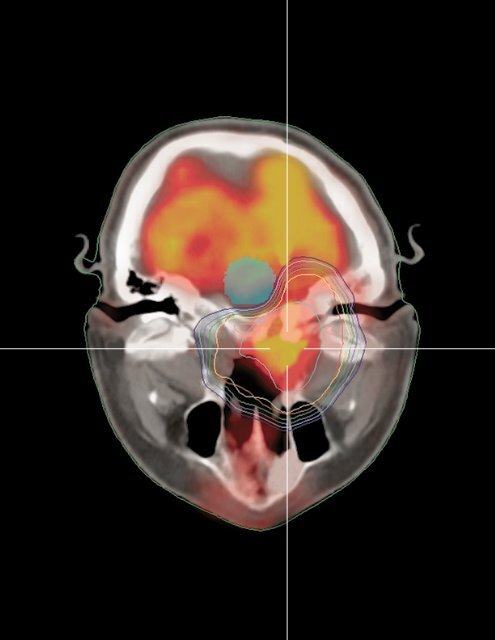Stereotactic Radiation Therapy: Expanding Capabilities - Varian
Stereotactic Radiation Therapy: Expanding Capabilities - Varian
Stereotactic Radiation Therapy: Expanding Capabilities - Varian
You also want an ePaper? Increase the reach of your titles
YUMPU automatically turns print PDFs into web optimized ePapers that Google loves.
VARIAN MEDICAL SYSTEMS 2003 ANNUAL REPORT DYNAMIC TARGETING IGRT—“WHAT’S NEXT?” 2<br />
Image-guided radiation therapy software can compare images of a patient's anatomy at the time of treatment with images that were used for diagnosis and treatment planning.<br />
If the patient's position is off even slightly, the software can calculate how to move the patient to bring both images into alignment.<br />
Search the Web for the expression “What’s next?” and you get more than 600,000 hits. Search<br />
Amazon.com and you will find the “What’s next?” question being posed in the title of<br />
300 books. “What’s next?” is an especially compelling question for technological advances<br />
where human curiosity is bolstered by an equally strong desire to take a good thing and make<br />
it even better. In the life and death endeavor of cancer treatment, the field of radiation<br />
oncology has witnessed one of its greatest technological changes ever – intensity-modulated<br />
radiation therapy or IMRT, a technique designed to deliver increasingly curative doses of<br />
X rays to tumor cells while sparing healthy cells from damage. Even as <strong>Varian</strong>’s SmartBeam <br />
IMRT is being established as the gold standard in<br />
radiation oncology, the “What’s next?” question is<br />
already being asked. At <strong>Varian</strong> Medical Systems,<br />
the answer is here: Dynamic Targeting imageguided<br />
radiation therapy (IGRT).<br />
THE FUTURE IS IN MOTION<br />
High-resolution radiation therapy techniques like<br />
IMRT enable doctors to plan and deliver radiation<br />
Dynamic Targeting IGRT:<br />
WHAT’S NEXT?<br />
The Trilogy system for image-guided radiation therapy and stereotactic<br />
applications will feature an on-board imaging accessory.
VARIAN MEDICAL SYSTEMS 2003 ANNUAL REPORT<br />
doses that conform tightly to the three-dimensional contours of a<br />
tumor. However, tumors are not stationary, unchanging targets;<br />
they move between and during daily treatments. For one thing,<br />
tumors are subject to changes in position due to unavoidable dayto-day<br />
variations in how patients are positioned for treatment.<br />
Even when patients are placed in precisely the same position for<br />
their daily treatments, some tumors can shift by as much as two<br />
to three centimeters over six to eight weeks of therapy. In<br />
addition, normal physiological processes like breathing cause<br />
some organs and tumors to move significantly during a daily<br />
treatment session.<br />
In a perfect world, all therapeutic X rays would be directed at<br />
tumor cells, with none directed at healthy cells. In the real world,<br />
to deal with tumor position uncertainties as well as tumor motion,<br />
doctors treat a margin of normal, healthy tissue around the<br />
tumor. This ensures that no part of the cancer is missed or underdosed.<br />
However, doctors could shrink the margin of healthy tissue<br />
treated if they had a way to see and adjust for changes in tumor<br />
position at the moment of treatment.<br />
“Image-guided radiotherapy will be of major importance in<br />
providing us with treatment technology that is accurate enough to<br />
allow us more precise margins around the tumors and hence to<br />
have more limited volumes, sparing non-targeted tissues,” said Dr.<br />
Jean Bourhis, head of the <strong>Radiation</strong> Oncology Department at the<br />
Institut Gustave-Roussy, in Villejuif, France, a leading expert on<br />
treating cancers of the head and neck.<br />
In addition, image-guided radiation therapy “takes into account<br />
the motion of organs such as the lungs, heart, and bowel,” said Dr.<br />
Richard Hoppe, chair of the <strong>Radiation</strong> Oncology Department at<br />
Stanford University. “By enabling us to track critical organ<br />
motions, this new technique could allow us to safely use higher<br />
doses, which should improve our ability to control tumors.”<br />
DYNAMIC TARGETING IGRT—“WHAT’S NEXT?”<br />
At the Tohoku University School of Medicine in Japan, Dr.<br />
Yoshihiro Takai has been investigating ways of using X-ray<br />
fluoroscopy to visualize the target on a daily basis and make<br />
positioning adjustments. “Set-up error and organ motion<br />
interferes with the accuracy of radiotherapy,” Dr. Takai said. “The<br />
important goal of shrinking the treatment margin can only be<br />
achieved with better patient positioning techniques.”<br />
In a recent editorial for <strong>Varian</strong>’s Centerline magazine, Dr. James<br />
Cox, head of the University of Texas M. D. Anderson Cancer<br />
Center’s Division of <strong>Radiation</strong> Oncology, wrote that the evolution<br />
of image-guided radiation therapy would expand the realm of<br />
treatable tumors. “We will be able to visualize and treat for the first<br />
time the elusive small lesions of the liver and other metastatic sites,<br />
potentially improving patient outcomes.”<br />
WHAT IS DYNAMIC TARGETING IGRT?<br />
“We are just at the beginning of implementing real image-guided<br />
therapy,” said Dr. Cox. “As we understand more about tumor<br />
motion, we have had to realize that we cannot position patients<br />
just on the basis of marks or tattoos on their external anatomy. As<br />
the treatments have become more conformal, and as we try to<br />
confine the high dose area much more strictly just to where the<br />
tumor is, we have to be all the more diligent in knowing exactly<br />
where the tumor is, every day.”<br />
Dynamic Targeting IGRT addresses this clinical challenge. It is<br />
an approach that uses patient positioning devices and imaging<br />
tools to target tumors more precisely. Dynamic Targeting IGRT<br />
helps clinicians in two important ways. It enables them to deal<br />
with the small set-up changes that are invariably introduced when<br />
a patient comes back and is positioned for daily treatments over a<br />
period of weeks. In addition, it provides doctors with ways of<br />
taking tumor motion into account during treatment planning,<br />
<strong>Stereotactic</strong> <strong>Radiation</strong> <strong>Therapy</strong>: <strong>Expanding</strong> <strong>Capabilities</strong><br />
Modern image-guided radiation therapy<br />
(IGRT) technologies are improving the<br />
precision of tumor targeting—even for<br />
tumors that are moving or changing<br />
over the course of treatment. As a<br />
result, doctors are able to reduce the<br />
duration of treatment for some patients.<br />
Conventional treatments and IMRT are<br />
typically delivered over a period of 6-8<br />
weeks. Using IGRT, doctors may be<br />
able to treat some tumors in less than<br />
a week. This accelerated schedule is<br />
termed “stereotactic radiotherapy” or<br />
“stereotactic radiosurgery.”<br />
Up to now, stereotactic approaches<br />
have been used primarily by<br />
neurosurgeons to treat brain cancer,<br />
requiring special-purpose devices.<br />
Now, <strong>Varian</strong> is bringing this capability<br />
to general radiation therapy.<br />
During 2003, the company<br />
developed the world’s first imageguided<br />
radiation therapy system<br />
optimized for both conventional and<br />
stereotactic approaches to treating<br />
cancer. The versatile Trilogy system,<br />
with built-in IGRT hardware and<br />
software, is designed to deliver 3-D<br />
conformal radiotherapy, IMRT, stereotactic<br />
radiosurgery, fractionated<br />
stereotactic radiation therapy, and<br />
intensity-modulated radiosurgery.<br />
“We have designed the first<br />
practical, clinically-viable system for<br />
delivering all forms of external-beam<br />
radiation therapy,” said Timothy<br />
Guertin, president of <strong>Varian</strong>’s Oncology<br />
Systems business. “<strong>Varian</strong>’s goal is to<br />
enable radiation oncologists to deliver<br />
the full spectrum of treatments, all on<br />
one machine in a single room.” ■<br />
A treatment plan for the stereotactic<br />
treatment of an intracranial tumor.<br />
3
VARIAN MEDICAL SYSTEMS 2003 ANNUAL REPORT<br />
“We will be able to visualize<br />
and treat for the first time the<br />
elusive small lesions of the<br />
liver and other metastatic sites,<br />
potentially improving patient<br />
outcomes.”<br />
Dr. James Cox<br />
simulation, and most importantly, during radiation therapy<br />
treatment delivery.<br />
“Dynamic Targeting image-guided radiation therapy gives<br />
doctors a way to see exactly where a tumor is, and how it is<br />
moving, every day just prior to treatment and even during the<br />
treatment,” said Calvin Huntzinger, M.S., product manager for<br />
<strong>Varian</strong>’s Dynamic Targeting IGRT initiative. “This is certain to<br />
make it possible for doctors to use radiation therapy to treat<br />
tumors that were not readily treatable before.”<br />
“<strong>Varian</strong>’s current tools for Dynamic Targeting IGRT include<br />
the Exact Couch with Indexed Immobilization for patient<br />
positioning, the Acuity simulator, the PortalVision electronic<br />
digital imaging system, and RPM Respiratory Gating,” said<br />
Huntzinger. “Each of these tools is designed to help clinicians plan<br />
and compensate for tumor motion and day-to-day changes in<br />
tumor position.”<br />
IGRT AND STEREOTACTIC RADIOTHERAPY:<br />
SHORTENING THE COURSE OF TREATMENT<br />
Because Dynamic Targeting IGRT improves precision, it also<br />
raises the possibility of reducing the 30 to 40 daily treatment<br />
sessions or “fractions” normally needed for delivering a total dose<br />
of radiation. With improved imaging and delivery technology,<br />
some small lesions could be treated in a single session with “stereotactic<br />
radiosurgery.” Others could be treated in as few as three to<br />
five sessions with “stereotactic radiotherapy.” Doctors agree that<br />
the possibilities are enormous. According to Dr. Hoppe, an IGRT<br />
approach that enables doctors to apply higher radiation doses over<br />
a smaller number of fractions “could mean a better tumor<br />
response to individual doses and greater convenience for the<br />
patient because the number of treatment sessions is reduced.”<br />
Dr. Cox and his colleagues have been working with an<br />
EXaCT Targeting System that pairs a CT scanner from GE<br />
Medical Systems with a Clinac ® medical linear accelerator from<br />
<strong>Varian</strong> Medical Systems, to investigate some of the possibilities<br />
that IGRT creates.<br />
“We’ve developed a program for stereotactic treatment of<br />
spinal tumors,” he said. “We’re using a very few fractions to treat<br />
tumors in the vertebral body. We have to hit the tumor precisely,<br />
but miss the spinal cord that’s only millimeters away.” While spinal<br />
tumors are not prone to tumor motion, patient set-up<br />
uncertainties have precluded this kind of treatment in the past.<br />
“We never asked our set-up procedures for this level of precision<br />
DYNAMIC TARGETING IGRT—“WHAT’S NEXT?”<br />
before, and now we must. In these cases, we are imaging before<br />
every treatment session, and we usually move the patient a few<br />
millimeters prior to each treatment.”<br />
RESPIRATORY GATING:<br />
COMPENSATING FOR BREATHING MOTION<br />
One very important Dynamic Targeting IGRT technology is<br />
<strong>Varian</strong>’s Real-Time Position Management (RPM) Respiratory<br />
Gating System. With this system, physicians can select the<br />
optimal moment in the patient’s breathing cycle to image and<br />
treat a tumor.<br />
Dr. Anthony M. Berson, chairman of the Department of<br />
<strong>Radiation</strong> Oncology at St. Vincent’s Comprehensive Cancer<br />
Center in New York, was one of the earliest adopters of RPM<br />
Respiratory Gating for the treatment of lung cancer.<br />
According to Dr. Berson, tumors in the middle or lower lung<br />
lobes are the ones that move the most as the patient breathes, as a<br />
result of the diaphragm moving up and down. Respiratory gating<br />
enables him to treat these tumors by turning the delivery beam on<br />
and off as the tumor moves in and out of range.<br />
“We’ve probably treated between 200 and 300 patients with the<br />
respiratory gating technique,” he said. “This has allowed us to<br />
reduce the volume of lung that we’re treating so we’ve been able<br />
to treat some sicker patients who have poor pulmonary function.<br />
You don’t want to touch the little bit of normal lung they still have,<br />
and respiratory gating helps us to avoid the normal lung. Also,<br />
we’ve been able to treat lung tumors at higher radiation doses,<br />
since we’re minimizing the amount of healthy lung tissue exposed<br />
to the beam.”<br />
Initially, Dr. Berson focused on treating later-stage cancer<br />
patients with metastases—people suffering from advanced disease<br />
who were not likely to be cured, but could be made more<br />
comfortable and given a better quality of life. However, referring<br />
physicians have begun sending early-stage lung cancer patients to<br />
Dr. Berson for curative treatment with respiratory gating.<br />
“These are the kinds of cases that are often treated with<br />
surgery, but for one reason or another, some patients are not<br />
good candidates for surgery. We can eliminate these small, earlystage<br />
tumors very precisely using radiation therapy with<br />
respiratory gating,” Dr. Berson said. “The patients tolerate the<br />
treatment very well. We’ve been able to accurately deliver lung<br />
cancer treatments this way, with a high level of comfort and<br />
confidence in the process.”<br />
“The important goal of<br />
shrinking the treatment<br />
margin can only be achieved<br />
with better patient positioning<br />
techniques.”<br />
Dr. Yoshihiro Takai<br />
4
VARIAN MEDICAL SYSTEMS 2003 ANNUAL REPORT<br />
“We can eliminate these<br />
small, early-stage tumors<br />
very precisely using radiation<br />
therapy with respiratory<br />
gating.”<br />
Dr. Anthony Berson<br />
OTHER DYNAMIC TARGETING IGRT TECHNOLOGIES<br />
<strong>Varian</strong>’s Dynamic Targeting IGRT tools also include the Acuity<br />
system for simulation, treatment planning, and verification,<br />
which allows clinicians to work out patient positioning strategies<br />
and study tumor motion long before the patient is treated on the<br />
linear accelerator. <strong>Varian</strong>’s PortalVision digital imaging<br />
accessory for the Clinac linear accelerator is another important<br />
Dynamic Targeting IGRT tool, used to verify that a patient has<br />
been properly positioned, that the targeted treatment area is<br />
lined up before a treatment session begins, and also to confirm<br />
that the X-ray dosages were accurately administered during<br />
treatment. In addition, a new Portal Dosimetry option shows<br />
clinicians whether the delivered dose matched the planned dose<br />
distribution pattern.<br />
With the Acuity system, RPM Respiratory Gating, and<br />
PortalVision, <strong>Varian</strong> is well on the way towards solving the<br />
problems of planning, positioning, tumor motion compensation,<br />
and verification. Even with these advances, however, imageguided<br />
radiotherapy continues to evolve. “The more precise we<br />
get, the more we open the door to a new set of problems,” said<br />
Dr. Cox, of M. D. Anderson. “We’re now at the point of needing<br />
not only image guidance, but real-time image guidance.”<br />
Consequently, an important next step is to outfit the linear<br />
accelerator with a new, “on-board” X-ray imaging system, giving<br />
doctors a view of the tumor and surrounding anatomy just before,<br />
and even during, treatment. Not surprisingly, <strong>Varian</strong> is on the way<br />
to offering clinics just such a system.<br />
RESEARCH AND DEVELOPMENT:<br />
ON-BOARD IMAGING<br />
Adapting components that were originally developed for—and<br />
are already integral to—the Acuity simulation system, <strong>Varian</strong><br />
plans to outfit the Clinac and Trilogy linear accelerators with a<br />
special low-dose “on-board” X-ray imaging system. Like Acuity,<br />
the planned on-board imager will incorporate a special X-ray<br />
tube and a high-speed, amorphous silicon flat-panel X-ray<br />
image detector mounted on a pair of robotic arms. In this<br />
system, a low energy beam will provide high-resolution images<br />
that can be acquired with a minimum of dose to the patient.<br />
Highly specialized software will be incorporated to manage<br />
these images and compare them to reference images from<br />
diagnostic and simulation steps, so that minute adjustments in a<br />
patient’s position can be made automatically.<br />
DYNAMIC TARGETING IGRT—“WHAT’S NEXT?”<br />
<strong>Varian</strong>’s new on-board imaging system will operate in several<br />
imaging modes, so that doctors can use it in a variety of ways:<br />
A radiographic mode will use standard diagnostic X rays to<br />
visualize the bony anatomy around a patient’s tumor, or marker<br />
seeds that have been placed in or near the tumor. This imaging<br />
mode will be useful for daily review and adjustments in patient<br />
positioning.<br />
A fluoroscopic mode will convert fast sequences of X rays into<br />
“live” moving images, enabling clinicians to verify positioning<br />
accuracy and implement treatment plans that involve tumor<br />
motion and respiratory gating.<br />
A “cone-beam CT” mode will yield three-dimensional images<br />
of soft-tissue targets. It will be useful in situations when soft tissues<br />
are best visualized directly, for example in the case of prostate<br />
cancer or liver metastases.<br />
“In addition to providing doctors with various kinds of useful<br />
images, an ideal on-board imaging system will fully integrate with<br />
the rest of the radiation therapy process, so the images obtained<br />
can be instantly compared, on-line, with images from other parts<br />
of the treatment process,” Huntzinger said. “This will allow<br />
immediate adjustments and corrections in plans or patient<br />
positioning.” This product will need to obtain 510(k) clearance<br />
from the FDA.<br />
WHAT’S NEXT<br />
Adding imaging capabilities to the linear accelerator is only one<br />
piece in <strong>Varian</strong>’s overall strategy. “The goal of our Dynamic<br />
Targeting IGRT initiative is to provide all the tools needed to<br />
compensate for all forms of tumor motion,” said Timothy<br />
Guertin, president of <strong>Varian</strong>’s Oncology Systems unit. “We’re<br />
committed to offering radiation oncology departments a comprehensive<br />
suite of connected and integrated products that automatically<br />
tie together all the steps involved in planning and delivering<br />
image-guided radiation therapy.”<br />
Says Huntzinger, “Dynamic Targeting IGRT will give<br />
radiation oncology teams unprecedented dynamic tracking<br />
capabilities as well as better-than-ever patient positioning and<br />
treatment verification capabilities. With the added ability of being<br />
able to make targeting adjustments just prior to, or in the midst of<br />
a treatment—something we envision in the not-too-distant<br />
future—<strong>Varian</strong>’s Dynamic Targeting IGRT initiative will enable<br />
radiation oncologists to precisely hit even a moving target.” ■<br />
“The goal of our Dynamic<br />
Targeting IGRT initiative is to<br />
provide all the tools needed to<br />
compensate for all forms of<br />
tumor motion.”<br />
Timothy Guertin<br />
5
VARIAN MEDICAL SYSTEMS 2003 ANNUAL REPORT<br />
IMRT Today<br />
When Patsy Huban, 57, was diagnosed<br />
with a rare form of throat cancer, her<br />
husband immediately began researching<br />
her treatment options and discovered<br />
IMRT. To get access to this technology,<br />
the couple drove 70 miles from their<br />
home in Athens, Georgia, to Emory<br />
University Hospital in Atlanta every day<br />
for 33 days so that Patsy could receive<br />
IMRT to destroy her cancer while<br />
preserving her hearing, her speech,<br />
her teeth, and her salivary function—<br />
all of which otherwise would have<br />
been at risk.<br />
“My doctor told me that, of all the<br />
places to have radiation, mine was the<br />
most challenging because of all the<br />
delicate tissues nearby,” Huban said.<br />
“Luckily, IMRT was available at Emory.<br />
I feel very, very lucky,” she said.<br />
Patients around the world are<br />
discovering IMRT—on the Web, in<br />
news reports, and in materials mailed<br />
by hospitals that offer IMRT. In the last<br />
year, major news stories about IMRT<br />
appeared in national publications like<br />
USA Today, Newsweek, Business Week,<br />
Forbes, Investor’s Business Daily, and<br />
in hundreds of regional papers like<br />
the Chicago Sun-Times, Pittsburgh<br />
Post-Gazette, San Jose Mercury News,<br />
Houston Chronicle, Miami Herald,<br />
South China Morning Post and<br />
Hindustan Times. IMRT stories also<br />
ran on news broadcasts on ABC, NBC,<br />
and CBS affiliated television stations<br />
in the U.S., and on the BBC in the<br />
United Kingdom.<br />
The number of cancer treatment<br />
centers offering <strong>Varian</strong>’s SmartBeam <br />
IMRT has been more-than-doubling<br />
every year. In 1997, there was one<br />
SmartBeam IMRT site in the world. By<br />
the year 2000, this number had grown<br />
to 40. The number jumped to 82 in<br />
2001 and to 188 in 2002. In 2003,<br />
the number shot up again, to 472. At<br />
this rate, the number of clinics offering<br />
IMRT could well rise to 1,000 by the<br />
end of 2004.<br />
While IMRT is still primarily used<br />
at many clinics for treating cancers of<br />
the prostate, head and neck, and<br />
breast, doctors have also begun to use<br />
it to treat gynecologic tumors,<br />
pancreatic cancer, gastro-intestinal<br />
tumors, pediatric cancers, lung cancer,<br />
central nervous system and brain<br />
tumors, lymphoma, sarcoma, and<br />
mesothelioma.<br />
Said Dr. Arno J. Mundt, radiation<br />
oncologist at the University of Chicago,<br />
who has studied the adoption of IMRT<br />
at medical institutions across the<br />
country: “The literature has established<br />
that IMRT is superior to conventional<br />
techniques in many tumor sites, and<br />
data is now accumulating to suggest<br />
that the benefits of IMRT translate into<br />
lower rates of toxicity and, in select<br />
sites, improved tumor control.”<br />
The word about IMRT is getting out<br />
and cancer patients, like Patsy Huban,<br />
are starting to ask their doctors if IMRT<br />
is right for them.<br />
David Prislupsky was treated for<br />
prostate cancer at the The Dale and<br />
Frances Hughes Cancer Center in East<br />
Stroudsburg, Pennsylvania. He’d been<br />
considering laparoscopic surgery,<br />
when he found out about IMRT from<br />
DYNAMIC TARGETING IGRT—“WHAT’S NEXT?”<br />
another man in his cancer patient<br />
support group.<br />
“He told me all about it and I was<br />
interested,” Prislupsky recalled. “He’d<br />
downloaded information from the<br />
Internet about IMRT at Memorial Sloan-<br />
Kettering Cancer Center in New York,<br />
and he gave me a copy.” That led him<br />
to find an IMRT site in his area.<br />
“Being diagnosed with cancer is<br />
not a death sentence,” said Aileen<br />
Pruitt, 41, a cancer survivor who was<br />
treated for breast cancer at Martin<br />
Memorial Hospital in Stuart, Florida.<br />
Pruitt opted for a combination of<br />
chemotherapy and IMRT. Other than a<br />
slight reddening of the skin, there were<br />
no side effects from the 33 IMRT<br />
treatments she received and the<br />
outcome was successful.<br />
“You must check out all your<br />
options and go with the ones that<br />
make you feel most comfortable —<br />
sometimes, it means you have to<br />
travel to a treatment center where<br />
you can receive state-of-the-art<br />
IMRT treatment.” ■<br />
Patsy Huban, a head and neck cancer survivor who was treated with SmartBeam IMRT, enjoys riding horses with her husband on the family’s farm in Athens, Georgia.<br />
6











![[MSDS 126] Dow Corning 200 Fluid, 5 CST Part Number ... - Varian](https://img.yumpu.com/5104917/1/190x245/msds-126-dow-corning-200-fluid-5-cst-part-number-varian.jpg?quality=85)




